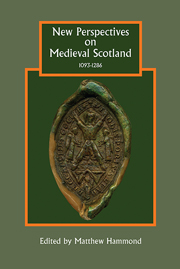Book contents
- Frontmatter
- Contents
- List of illustrations and tables
- List of contributors
- Acknowledgements
- Abbreviations
- Maps
- 1 Introduction: The paradox of medieval Scotland, 1093–1286
- 2 The Scottish ‘political community’ in the reign of Alexander II (1214–49)
- 3 Homo ligius and unfreedom in medieval Scotland
- 4 Scottish royal government in the thirteenth century from an English perspective
- 5 Neighbours, the neighbourhood, and the visnet in Scotland, 1125–1300
- 6 Cistercian identities in twelfth- and thirteenth-century Scotland: the case of Melrose Abbey
- 7 The language of objects: material culture in medieval Scotland
- 8 Structuring that which cannot be structured: a role for formal models in representing aspects of medieval Scotland
- Bibliography
- Index
- STUDIES IN CELTIC HISTORY
7 - The language of objects: material culture in medieval Scotland
Published online by Cambridge University Press: 05 August 2013
- Frontmatter
- Contents
- List of illustrations and tables
- List of contributors
- Acknowledgements
- Abbreviations
- Maps
- 1 Introduction: The paradox of medieval Scotland, 1093–1286
- 2 The Scottish ‘political community’ in the reign of Alexander II (1214–49)
- 3 Homo ligius and unfreedom in medieval Scotland
- 4 Scottish royal government in the thirteenth century from an English perspective
- 5 Neighbours, the neighbourhood, and the visnet in Scotland, 1125–1300
- 6 Cistercian identities in twelfth- and thirteenth-century Scotland: the case of Melrose Abbey
- 7 The language of objects: material culture in medieval Scotland
- 8 Structuring that which cannot be structured: a role for formal models in representing aspects of medieval Scotland
- Bibliography
- Index
- STUDIES IN CELTIC HISTORY
Summary
The material culture and archaeology of medieval Scotland are familiar from both archaeological excavation and museum collections, although that familiarity has often proved an impediment to a fuller understanding. Those objects commonly collected and curated by museums are typically of a particular quality, and this concentration on high-status objects can lead to a circular and self-fulfilling interpretation of their use and significance. The importance and meaning of these objects has often been overshadowed by the attention given to the wider historical picture, not least by archaeologists themselves, and it is a key question whether these objects are primarily illustrative and supportive of the broader historical narrative or whether they are a principal source of information. In the multi-disciplinary environment which is the study of medieval Scotland the same objects and artefacts are of interest not just to the archaeologist but also to the historian and art historian. Often, however, many pertinent questions can fall through the thematic and intellectual gaps between disciplines.
The relationship between historical archaeology and documentary history has commonly (and needlessly) been a vexed one through an unnecessary deference which archaeologists often show to the historical record. In truth, these difficulties are perhaps more apparent in the more earnest of conference halls than in practical application, yet the situation remains that many archaeologists prefer to interpret material culture using the safest and simplest of historical facts rather than examining the objects using a primarily archaeological methodology.
- Type
- Chapter
- Information
- New Perspectives on Medieval Scotland, 1093-1286 , pp. 183 - 202Publisher: Boydell & BrewerPrint publication year: 2013

